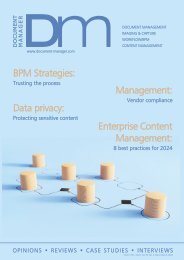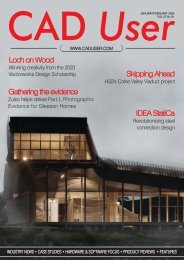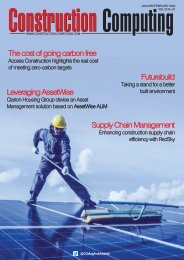DM Sep-Oct 2022
Create successful ePaper yourself
Turn your PDF publications into a flip-book with our unique Google optimized e-Paper software.
Dm STRATEGY: LOW-CODE<br />
How low can you code?<br />
Low-code automation is set to transform businesses - but what exactly is it, and<br />
what will it mean for how your organisation works? Tim Hood, Vice President EMEA<br />
and APAC, Hyland, has the answers<br />
For most companies, technology is the<br />
fundamental driving force - second<br />
perhaps only to people - behind their<br />
performance. It defines their productivity<br />
and agility: essential elements for success<br />
and survival in fast-changing markets.<br />
Yet many organisations are faced with a<br />
real challenge: They want to use technology<br />
in the best way possible, but find it difficult<br />
to deploy what's required. There are various<br />
reasons for this, including cost, poor<br />
understanding of the options available and<br />
a lack of resources to develop them.<br />
Is there a way around these issues? Yes.<br />
It's low- or no-code development tools<br />
that let you create new applications<br />
without having to write expensive,<br />
time-consuming and extremely<br />
detailed code.<br />
This can prove transformational for<br />
businesses that would otherwise be<br />
forced into a technology go-slow.<br />
Not surprisingly, a growing number<br />
of organisations are seeing it as the<br />
way forward. Research firm Gartner<br />
predicts that by 2025, seven out of<br />
ten new applications that are<br />
developed by enterprises will be<br />
created this way - a considerable rise<br />
from just 20% five years earlier.<br />
WHAT IS LOW-CODE AUTOMATION?<br />
It is a way to bypass the long-held<br />
approach to software development which<br />
relies on having access to developers with<br />
the knowledge to build an application<br />
from scratch.<br />
However, go to any large<br />
company and such demands<br />
are being placed on the IT<br />
department that you will<br />
almost certainly find a<br />
bottleneck, with an evergrowing<br />
backlog of<br />
projects waiting to be<br />
progressed.<br />
Because most legacy<br />
systems are so codeheavy<br />
- without the<br />
input of pro-coders - automation initiatives<br />
inevitably stall because there aren't<br />
specialty-based resources available to<br />
implement them.<br />
Understandably, mission-critical jobs are<br />
prioritised at the expense of less urgent<br />
tasks that might make life better or easier<br />
for a particular team or offer gradual<br />
improvements to workflows and processes.<br />
The alternative, of course, is to hire<br />
external developers. A sensible move in<br />
principle but difficult in practice, given the<br />
scarcity of suitably qualified individuals<br />
worldwide. Against a backdrop of a<br />
predicted global shortage of 85.2 million<br />
software engineers and other tech talent by<br />
2030, it's set to become more difficult.<br />
SOFTWARE WHERE IT'S NEEDED<br />
Under normal circumstances, new software<br />
systems are developed 'invisibly' elsewhere<br />
and then implemented from elsewhere in<br />
the organisation. Often this means they will<br />
be received, at best, with a lack of<br />
enthusiasm if they are considered<br />
unnecessary, fail to deliver significant<br />
improvements or are difficult to work with.<br />
On the other hand, no-code automation<br />
'democratises' software development by<br />
enabling non-technical staff to become<br />
actively involved in the development<br />
process. No-code accomplishes this by<br />
using drag-and-drop interfaces,<br />
checkboxes, drop-down menus and other<br />
user-friendly visual tools, rather than having<br />
to know and apply code.<br />
The benefit of this? It becomes much<br />
easier and faster to create the application<br />
that users want and need, and thereafter<br />
they can continue enhancing the original<br />
version in order for it to become an ever<br />
more bespoke piece of software.<br />
In other words, low- or no-code<br />
22<br />
@<strong>DM</strong>MagAndAwards<br />
<strong>Sep</strong>tember/<strong>Oct</strong>ober <strong>2022</strong><br />
www.document-manager.com

















